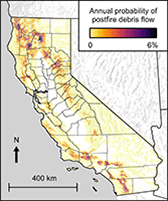Last Updated: 10 Jul 2025
Establishing Directions in Postfire Debris-Flow Science
Destructive postfire debris flows triggered by short-duration bursts of high-intensity rainfall and excessive runoff within 3 years following fire continue to impact California. Using a simplified wildfire scenario, we predicted potential postfire debris-flow hazards statewide. We suggest the maps are useful for identifying areas that pose the greatest postfire geohazards.
This article belongs to the collection: Establishing Directions in Postfire Debris-Flow Science.
Experimental instruments were placed in a burnt area and captured rainfall and extreme hydrologic responses, which is a challenging endeavor with conventional observing networks. Rainfall estimation from a mobile weather radar was shown to be as accurate as rain gauges, with the ability to resolve spatial rainfall fields.
This article belongs to the collection: Establishing Directions in Postfire Debris-Flow Science.



